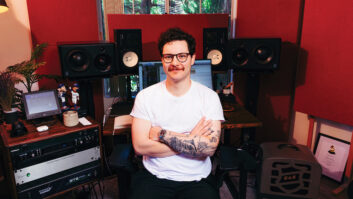Remember Ohio Express and their bookend hits “Yummy Yummy Yummy” and “Chewy, Chewy”? Joey Levine does. As a teenage singer/songwriter Levine penned and sang on those recordings. His credentials as an architect of what came to be known as “bubblegum music” may not gain Levine entrance into the pantheon of great 20th century composers, but it did set him up for a career as one of the top jingle writers and producers of the past quarter-century.
Despite 25 years in a business that is noted for people coming and going, Levine has plenty of energy and enthusiasm left for the job. Our tour through his West 57th Street studios was a kind of farewell journey, since Crushing Music, the company Levine founded in the mid-1970s, is getting ready to move later this year.
“The staff has been advocating a move for quite some time,” says Levine, who is largely producing jingles now, taking a break from writing in order to concentrate on the business. “This building is going to be torn down-when, I don’t know, but it’s going to happen. We have about 6,000 square feet in this building, just about a 1,000 square feet less than we’ll have in the new place. The problem here is that we kept adding on to our existing footage bit by bit, and we ended up with lots of cubbyholes. The new place will have a more well-thought-out design plan.”
One of the cubbyholes at Crushing Music is their kitchen. Over a cup of freshly ground coffee, I met Robin Batteau, a well-known and highly regarded singer/ arranger/producer who now makes his home at Crushing. You may not know his name, but if you own a television or radio, you’ve heard his voice. Robin wrote “The Heartbeat of America” for Chevrolet and sang it as well. Ditto Coke’s “Can’t Beat the Feeling” and you-know-who’s “Great Taste of McDonald’s.” I asked Batteau, who has spent plenty of time crafting pop songs, about the rewards (aside from the remuneration) that come from working in what can be a grueling and unpredictable industry.
“I like the immediacy of the advertising business,” he says. “You can work for two years on an album, and when it doesn’t turn into The Beatles’ ‘White Album’ be very upset. But a jingle is written and cut very quickly, and it’s on the air shortly thereafter, and that’s satisfying. There’s also something about getting your first idea down as the end result. Sometimes when you refine a song over and over again, you lose touch with your original impulse. There’s none of that danger with jingles because of the pressure to complete your work quickly.”
Jingle writers, no matter how successful, have to make peace with the fact that advertising is considered a second-class art in certain circles. I asked Batteau for his take on the topic. “Who knows how the future will judge the art of this time?” he asks. “Andy Warhol was simply painting Campbell’s soup cans, and now they’re considered important pieces of art. Maybe the most creative advertising music will be thought of as art in the future. You don’t know what throwaway art is going to become. Foster’s ‘Oh, Susanna’ was written as a jingle, not in the way we use the word today, but as a song used to promote the Pittsburgh Ice Cream Parlor!”
I also bumped into Christoph Goebel in the kitchen. Levine runs Crushing Music in a loose manner, but if titles were handed out, Goebel would be listed as the company’s chief technician. Jotting diagrams on a pad when we met, Goebel spoke about the design work for the new facility. “We’ll have eight writers’ rooms at the new place,” he says. “All of these people have their individual ways of working and will bring over their own gear. Lots of spots can be tracked and mixed in these rooms, but there will also be tielines to our main recording area so that large horn ensembles and other live performances can be sent into a writer’s room.”
Levine had CNN on when we spoke, joking about how he was watching the stock market to see how much dough he could drop on a console. His choices had narrowed down to either an SSL or Neve. “We’re definitely getting an analog console,” says Levine.
Adjacent to the main mix stage will be a Pro Tools room, outfitted with MIX Plus running on a Mac G4 with three ADAT interfaces. Levine and his staff were considering which mixing surface to use with Pro Tools. Although the Mackie HUI has some nice features, Goebel says, the fact that multiple HUIs can’t be cascaded is too much of a limitation for the way they work. “The HUI is great for applications where eight faders are all that’s needed,” he says, “but we need more, and so we’re thinking about going with multiple Pro Control surfaces, the ones that Digidesign makes for Pro Tools.”
Ad agencies like to get maximum mileage out of the tracks they buy these days, and it’s not unusual for a producer to ask a music house to cut new vocals (with new lyrics) to a track recorded several years earlier. Maintaining your catalog, then, is a major task when you’ve recorded -get this-approximately 15,000 pieces of music. At the new facility, all of these tracks will be listed in a central Filemaker Pro database, accessible through a central server by all of the writers. However, the goal of having the audio tracks themselves available as files on a central server will have to wait.
Several years ago, it looked as if ISDN might catch on as a way to shrink the audio post world and link up talent located in different areas, but Goebel says that Crushing’s ISDN connections have been used sporadically: “ISDN is very expensive, and the different boxes that are on the market aren’t compatible with each other.”
On the other hand, Goebel says, MP3 is catching on big time in the advertising world. “We’re sending more and more demos out as MP3 files,” he says. “They sound great for this application! We’ve spent as much as $200 shipping a track that we mix late at night out to L.A. for a 9 a.m. delivery. With MP3, we simply e-mail the file to an art director or post house-or both-and it’s there waiting for them.” Post houses often take these files, which are laid down with a two-beep, load them into their Avids and slide around the music to hit the opening frame.
Levine has felt all the waves that have washed through the jingle business since his early days in the industry, from the emphasis on a strong song to the emergence of sound design, to the heavy use of pop hits. He’s made a lot of money and has secured his reputation. When he ties on the cleats each morning, how does he maintain his passion for the game? “It goes on a job-to-job, person-to-person basis,” he says. “Some agency creatives and producers are open and easy to work with. The best of them realize that music creators need to be free to express themselves, too. Otherwise, you’re nothing more than a copy machine, giving musical form to someone else’s ideas. I really like working with some of the younger creatives. They have fresh ideas and energy.”
He’s been away from the record industry for several decades, but it looks like Levine is heading back that way. “For a while, I had self doubts about whether I could make records that were strong enough to compete in the marketplace,” he recalls. “Advertising music is a specialty that takes all of your energy. Now I have the confidence that I can make records that will sell again, and I’ve started working with a young female singer who has star appeal. There are lots of great singers in New York, but this girl is magnetic. I’m writing with and for her, and we’re getting ready to start recording some of the material.”
As for the jingle business, Levine says he’ll know when it’s time to bow out. “I don’t want to be like the ballplayer who stays in the game too long. I do want to be a coach, working with new people and ideas.”







